The USFS Collaborative Forest Restoration Program (CFRP) provides grants of up to $360,000 to stakeholders for forest restoration projects in New Mexico that are designed through a collaborative process. Projects can be up to four years in length and can be located on or on any combination of Federal, Tribal, State, County or Municipal forest land. Projects must address the following objectives: Wildfire threat reduction, Ecosystem restoration, including non-native species reduction, Reestablishment of historic fires regimes, Reforestation, Preservation of old and large trees, Small diameter tree utilization, and Creation of forest-related local employment.
To apply for a grant and other resources go to the main USFS CFRP webpage and USFS CFRP Training.
NMFWRI is involved in long term monitoring of selected CFRP Projects and other CFRP monitoring projects.
CFRP Resources and Working Papers
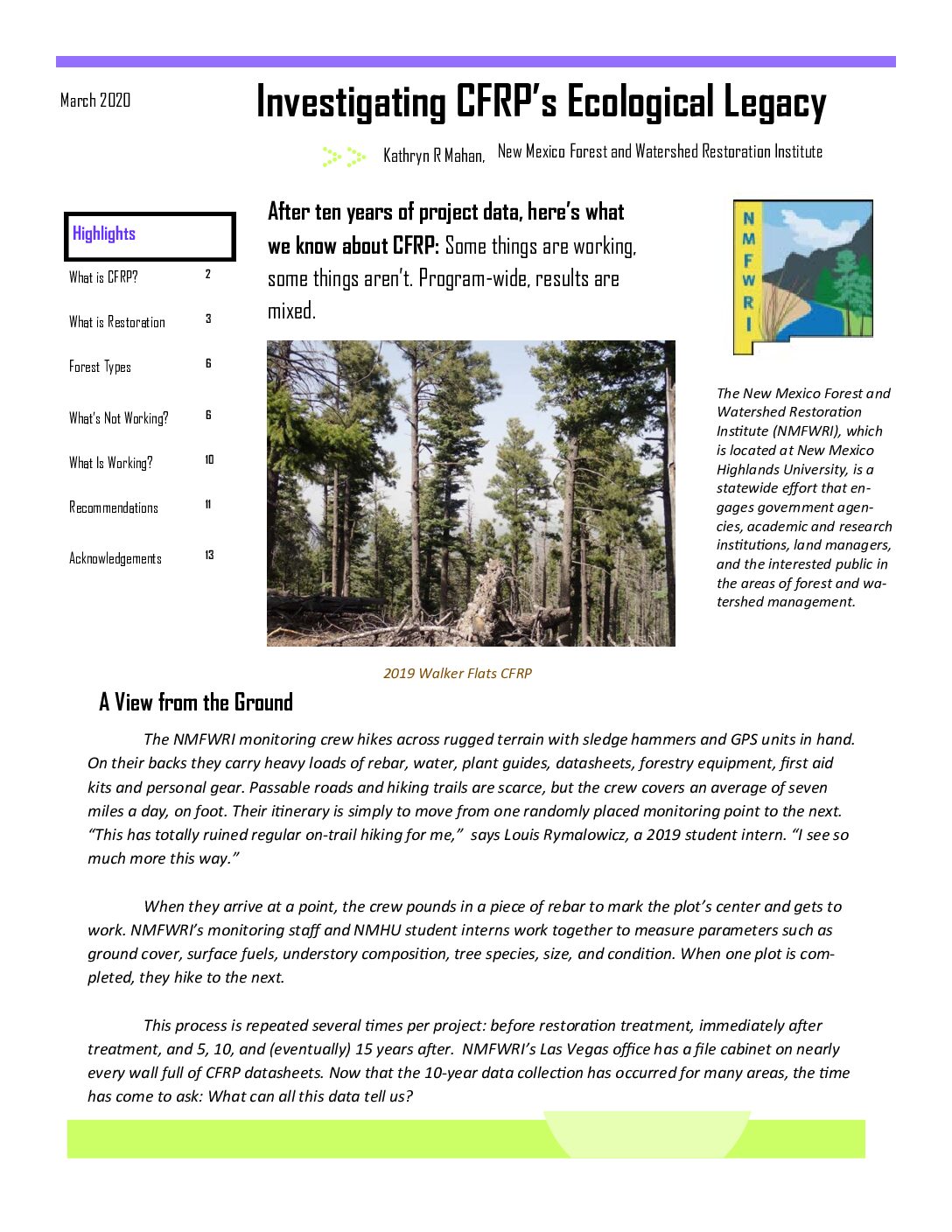
Investigating CFRP’s Ecological Legacy
NMFWRI has been responsible, as part of its Federal Workplan, for long-term vegetation monitoring of selected CFRP projects since 2007, and as of 2018 had gathered data on 35 CFRP projects. In 2018, NMFWRI began a 10-year review of available CFRP data to investigate the program’s success in meeting its ecological objectives. This newsletter-style summary is intended for managers, landowners, legislators and the interested public. This report includes a brief overview of the CFRP program, the need for restoration in New Mexico’s forests, and the ecological strengths and weaknesses of CFRP over the past 15 years. An update and integration of this ecological review along with social and economic reviews is underway and is expected to be available in 2021.
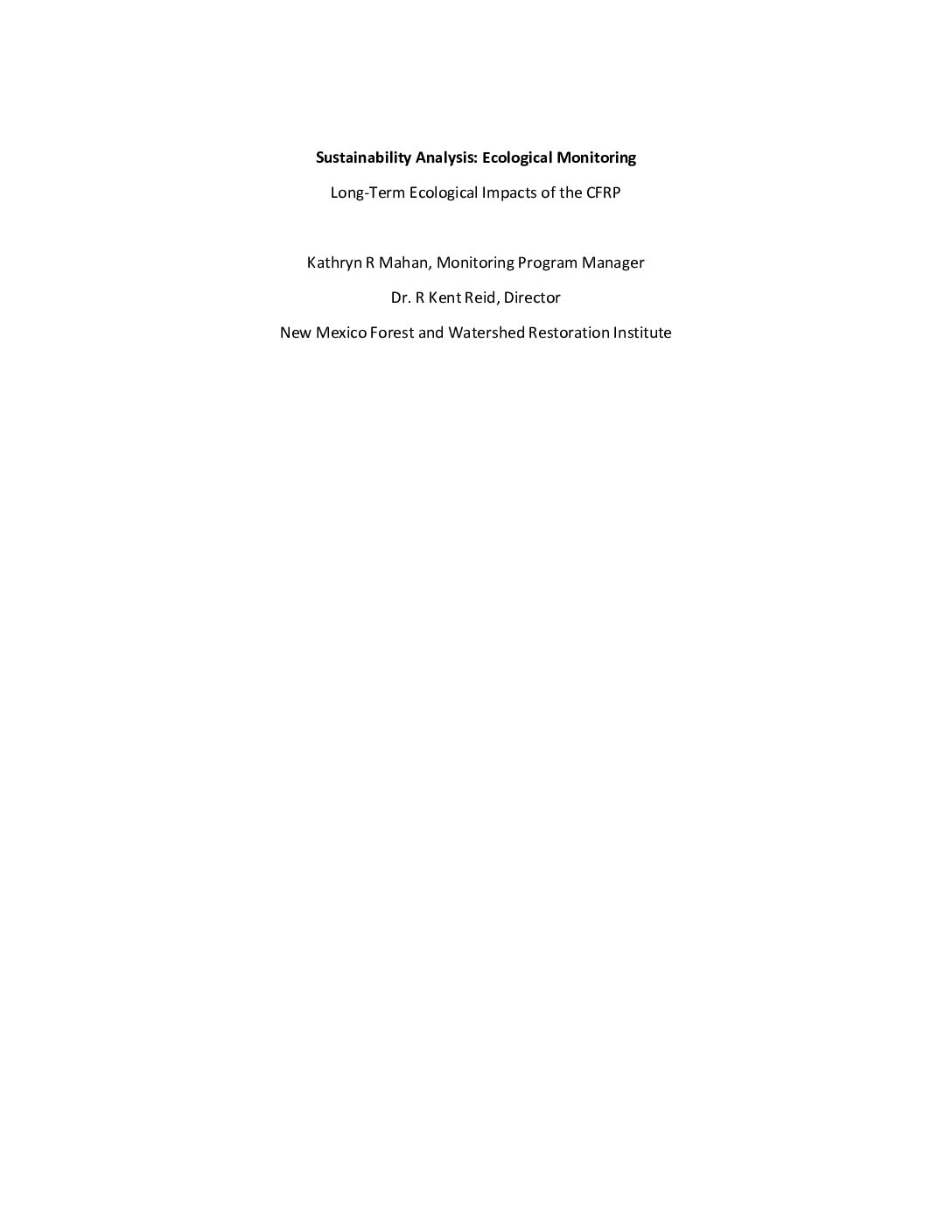
Sustainability Analysis: Ecological Monitoring Long-Term Ecological Impacts of the CFRP
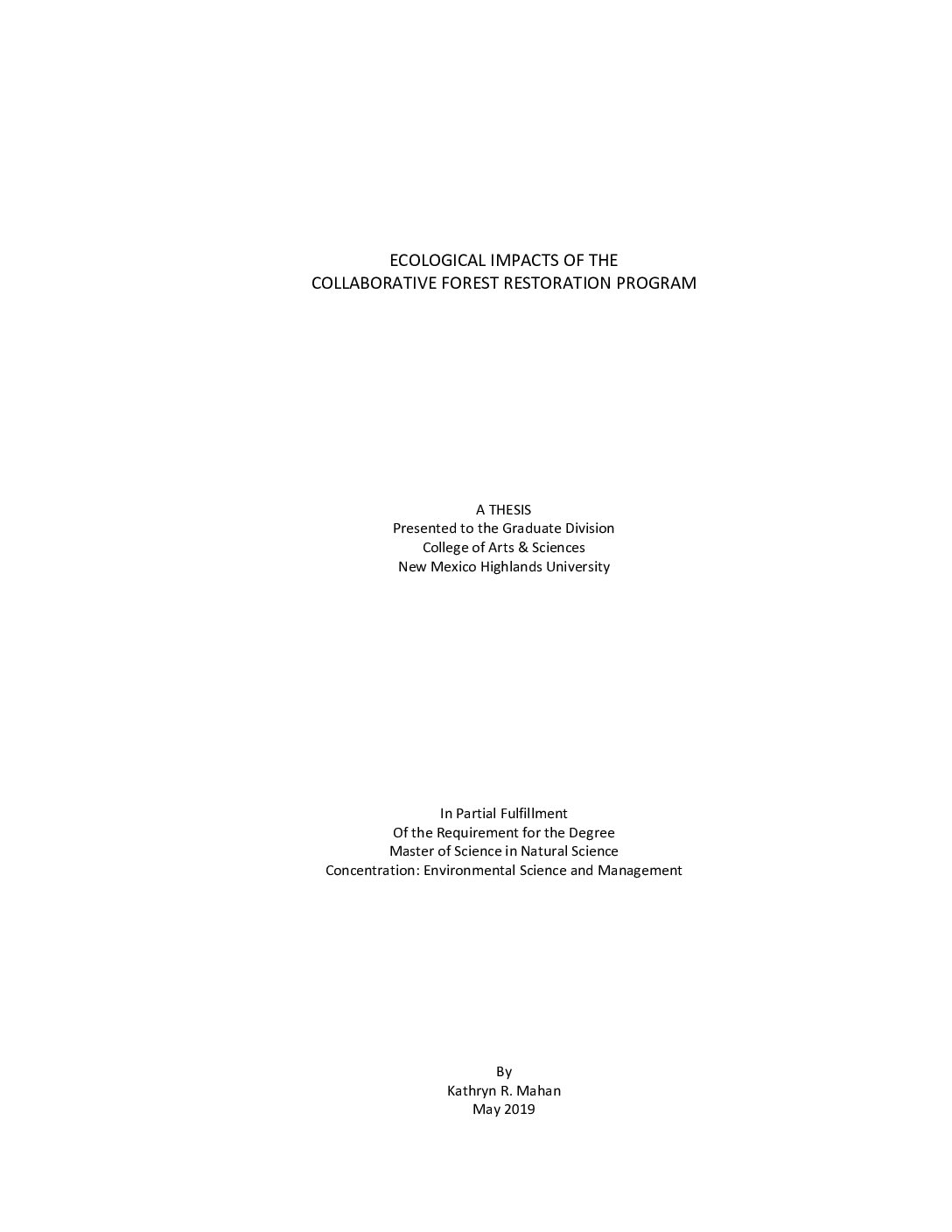
Ecological Impacts of the Collaborative Forest Restoration Program
A 2019 Master’s Thesis intended for Southwest forest managers, CFRP participants, and collaborators. This thesis details the process and results of the ecological analysis and includes information on the history of CFRP, ongoing monitoring challenges and recommendations for next steps. An update and integration of this ecological review along with social and economic reviews is underway and is expected to be available in 2021.

Involving Rural Communities In Forest Management: New Mexico’s Collaborative Forest Restoration Program
In the past decade, forest restoration and community wildfire protection have become increasingly important as fire suppression and other human activities have led to increased tree densities and an increased fire risk in forests throughout New Mexico and the southwestern United States. This increased fire risk comes at a time when the wildland-urban interface is steadily expanding in New Mexico, particularly in forested regions that are desired vacation destinations such as Ruidoso, Taos, Red River, and Silver City. In response, forest managers and landowners want to thin forests to reduce hazardous fuel loads and to “restore” forests to pre-European settlement conditions when tree densities were lower and fire disturbance was frequent but less severe, especially in ponderosa pine dominated forests (Covington et al. 1997).
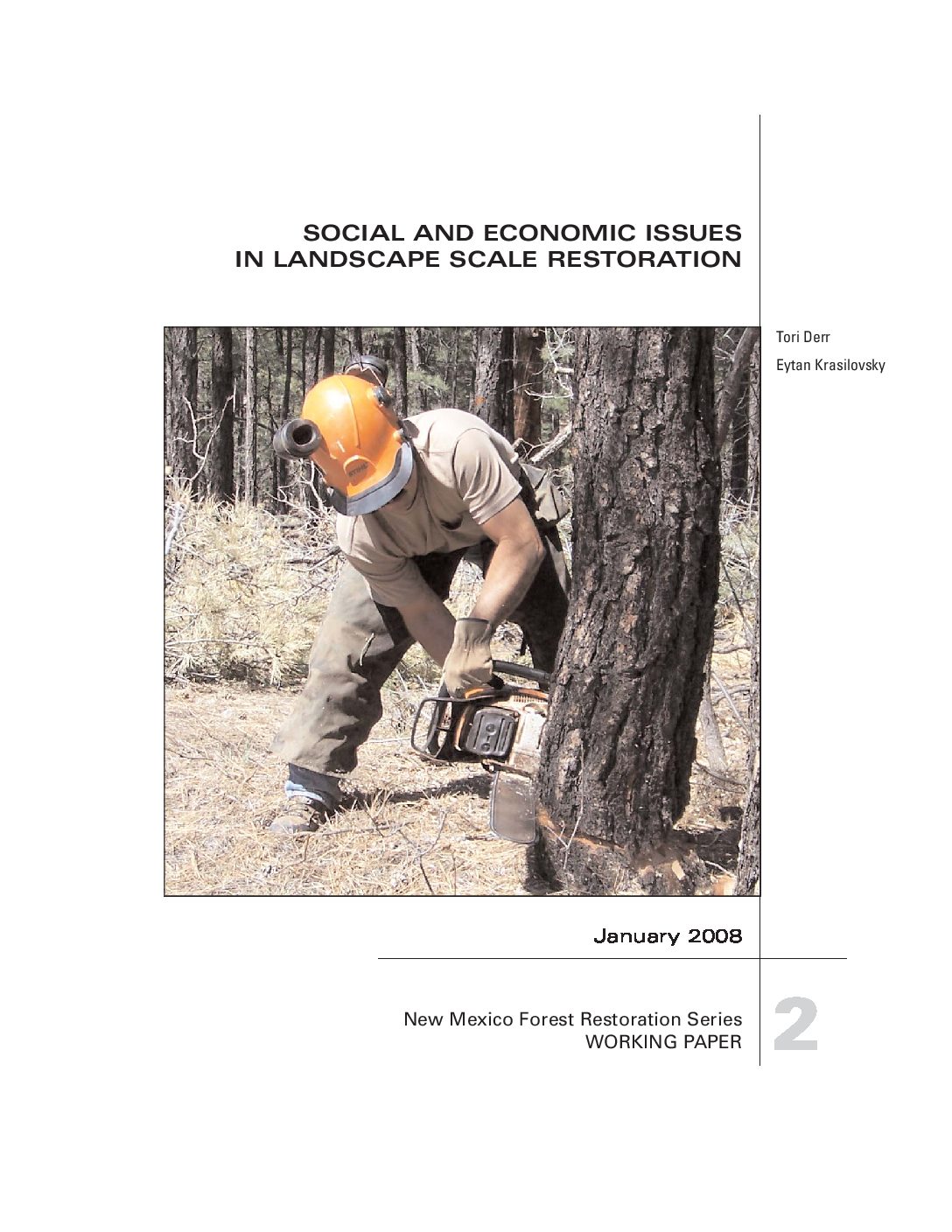
Social and Economic Issues in Landscape Scale Restoration
The purpose of this document is to assist prospective CFRP grantees in considering some of the important socioeconomic considerations that affect restoration at a landscape scale. Others considering landscape scale restoration in New Mexico may also find this tool helpful in project planning.
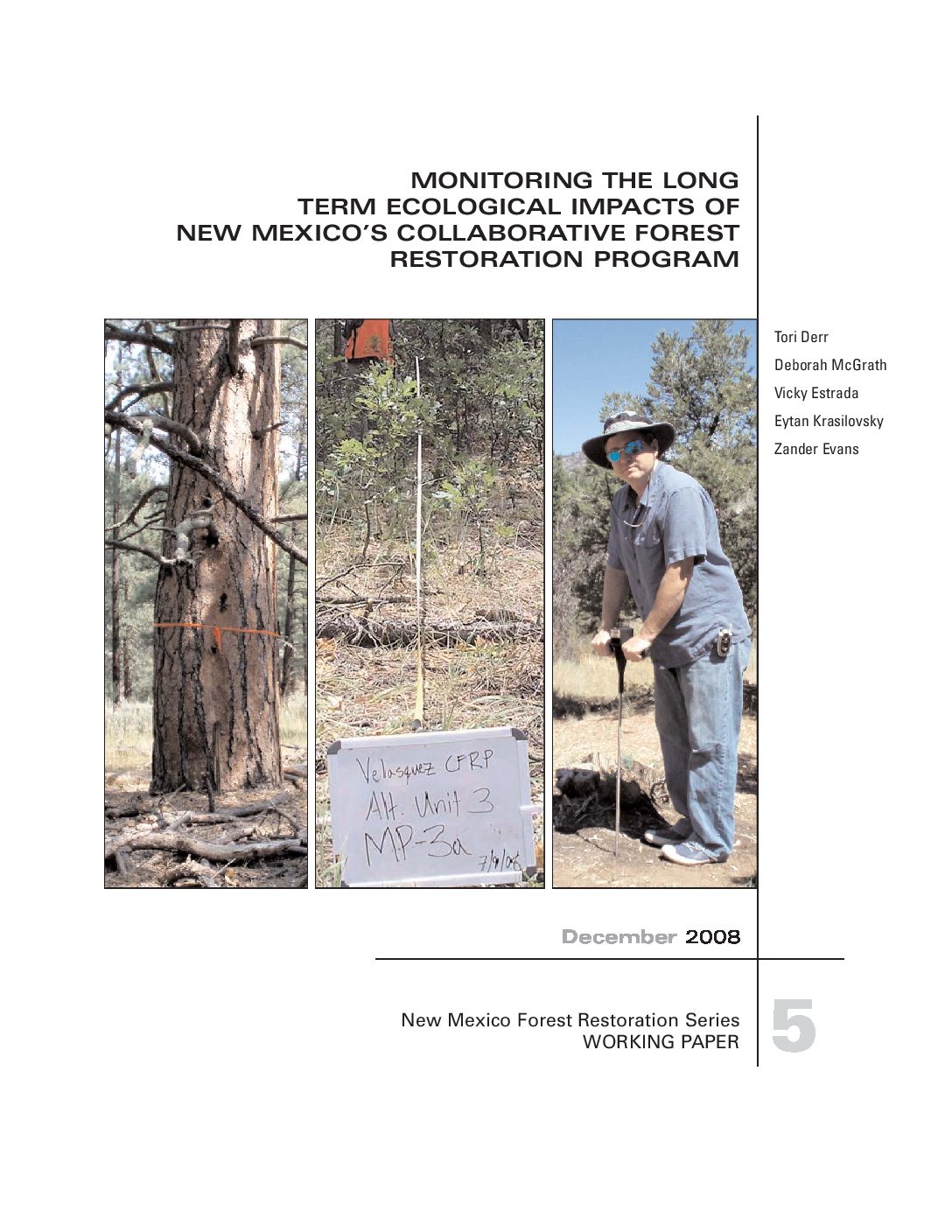
Monitoring The Long Term Ecological Impacts Of New Mexico’s Collaborative Forest Restoration Program
The CFRP requires individual grantees to monitor the effects of their work during and after project implementation. However, following project completion, the New Mexico Forest and Watershed Restoration Institute is ideally positioned for monitoring all long term project impacts. In Section 1, we review the multiparty monitoring process employed for ecological monitoring of CFRP projects. In Section 2, we describe the methods used to conduct a meta-analysis of the 102 projects that were funded at the time of analysis and recommend 20 projects for long term monitoring. In Section 3, we present our final list of 20 recommended projects in the context of all 102 CFRP projects. We discuss recommended indicators and protocols for long term monitoring in Section 4, and present a timeline for long term monitoring of the 20 recommended projects.
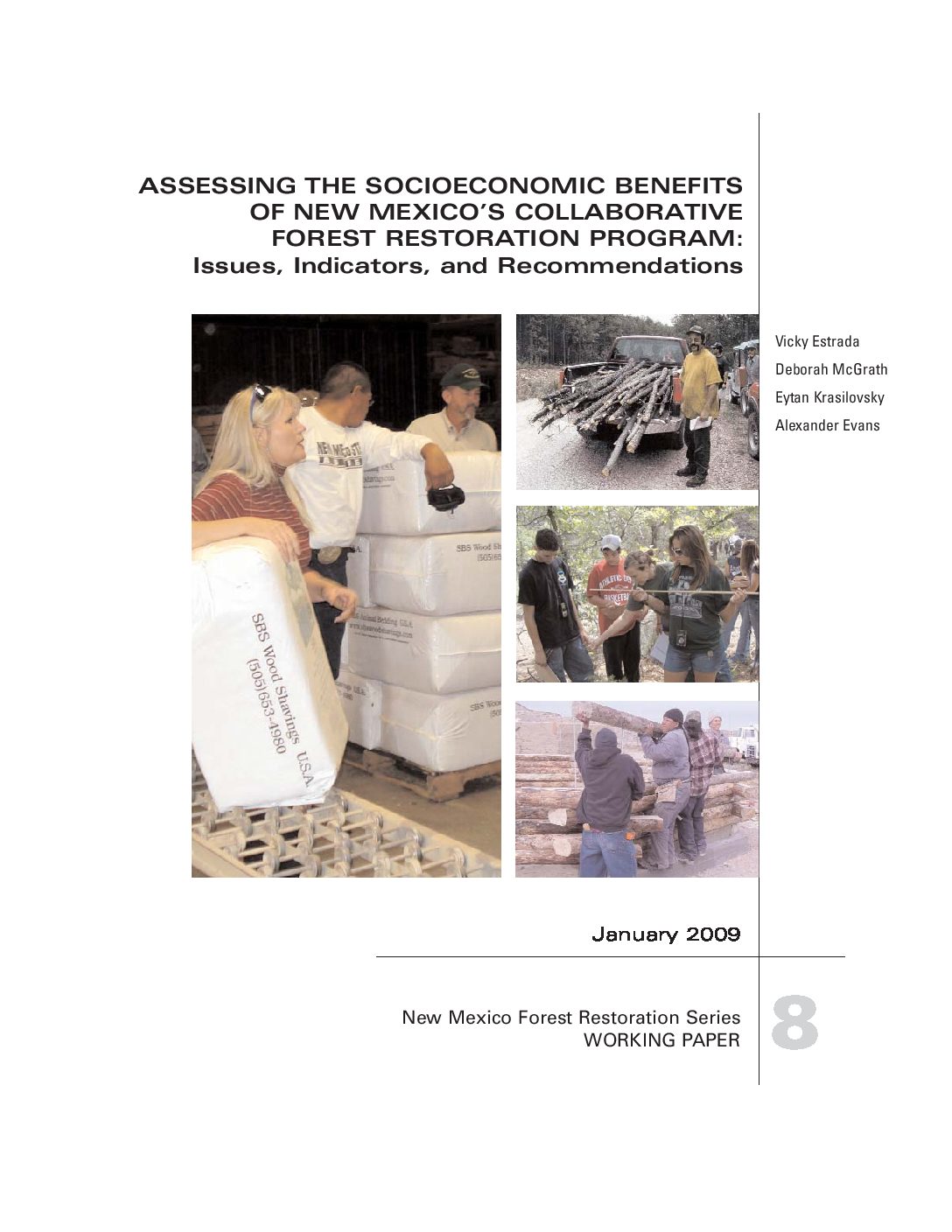
Assessing the Socioeconomic Benefits
In this paper, we examine the first seven years of the CFRP to assess the socioeconomic benefits derived to date. Because individual project success is critical to community-based forest restoration, we also draw lessons from project experiences and review challenges and opportunities for improving program monitoring and impact. In Section 1, we examine past projects to identify socioeconomic issues that strongly influence project implementation and success. We begin by outlining key factors contributing to successful project implementation, including (i) workforce sustainability, (ii) sustainable business operations, (iii) problem-solving in integrated land management, and (iv) small wood utilization. We then study these factors more comprehensively in two case studies that demonstrate different facets of community-based forest restoration. In Section 2, we conduct an analysis of past socioeconomic monitoring efforts. Based upon this analysis, we offer recommendations for monitoring indicators that will track issues discussed in Section 1. We conclude by summarizing some of the challenges still facing grantees and project partners and provide some socioeconomic monitoring recommendations to help improve future project planning and implementation, which will ultimately strengthen and broaden the socioeconomic impact of collaborative forest restoration on communities.
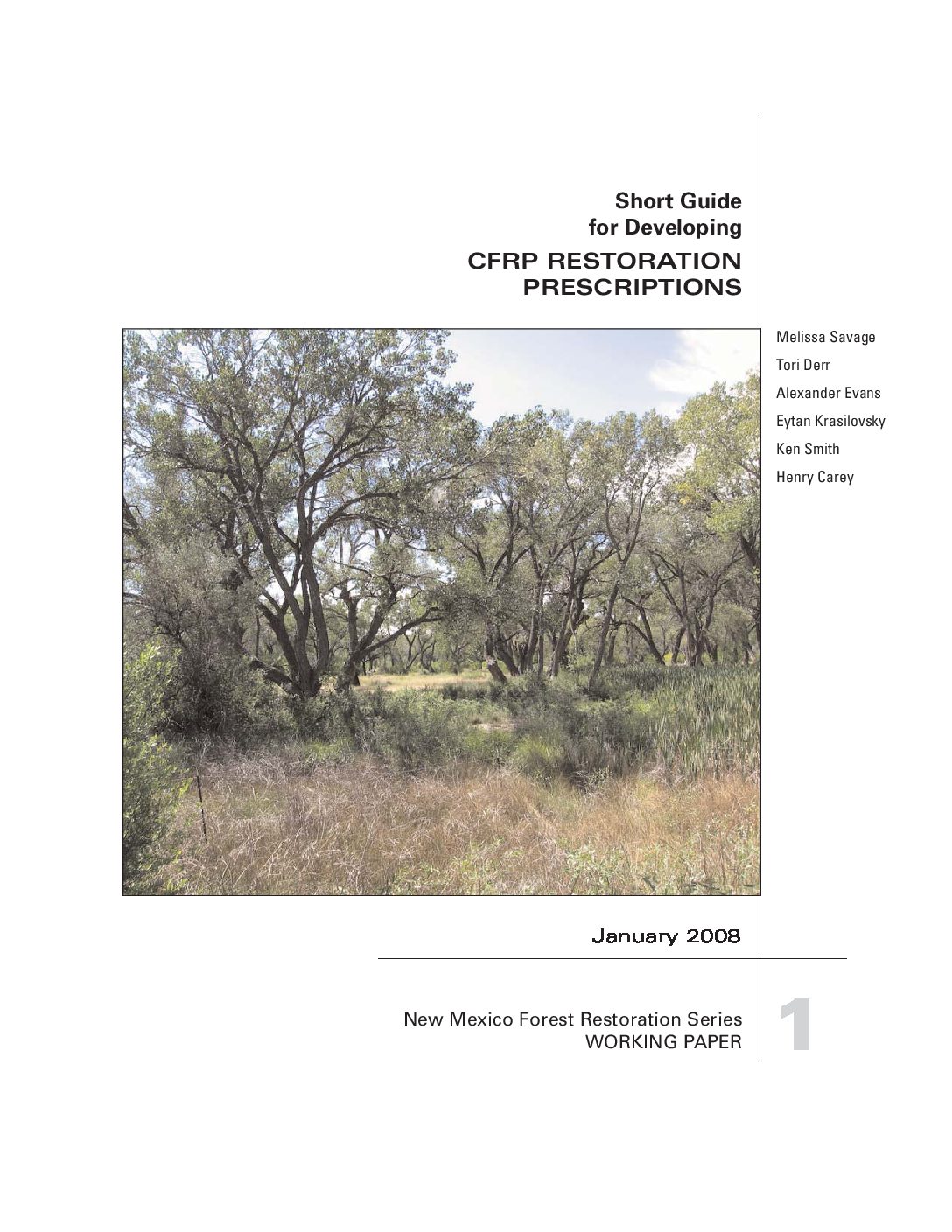
Short Guide for Developing CFRP Restoration Prescriptions
The purpose of this short guide is to provide information to assist Collaborative Forest Restoration Program (CFRP) grant recipients in designing a restoration prescription that will move forests toward healthier, more natural conditions. Forest stands vary considerably from place to place because of forest type, site history and forest structure. CFRP project collaborators should develop a prescription specific to the site to be treated. A prescription should be based on current conditions, targeted desired future conditions and restoration goals.
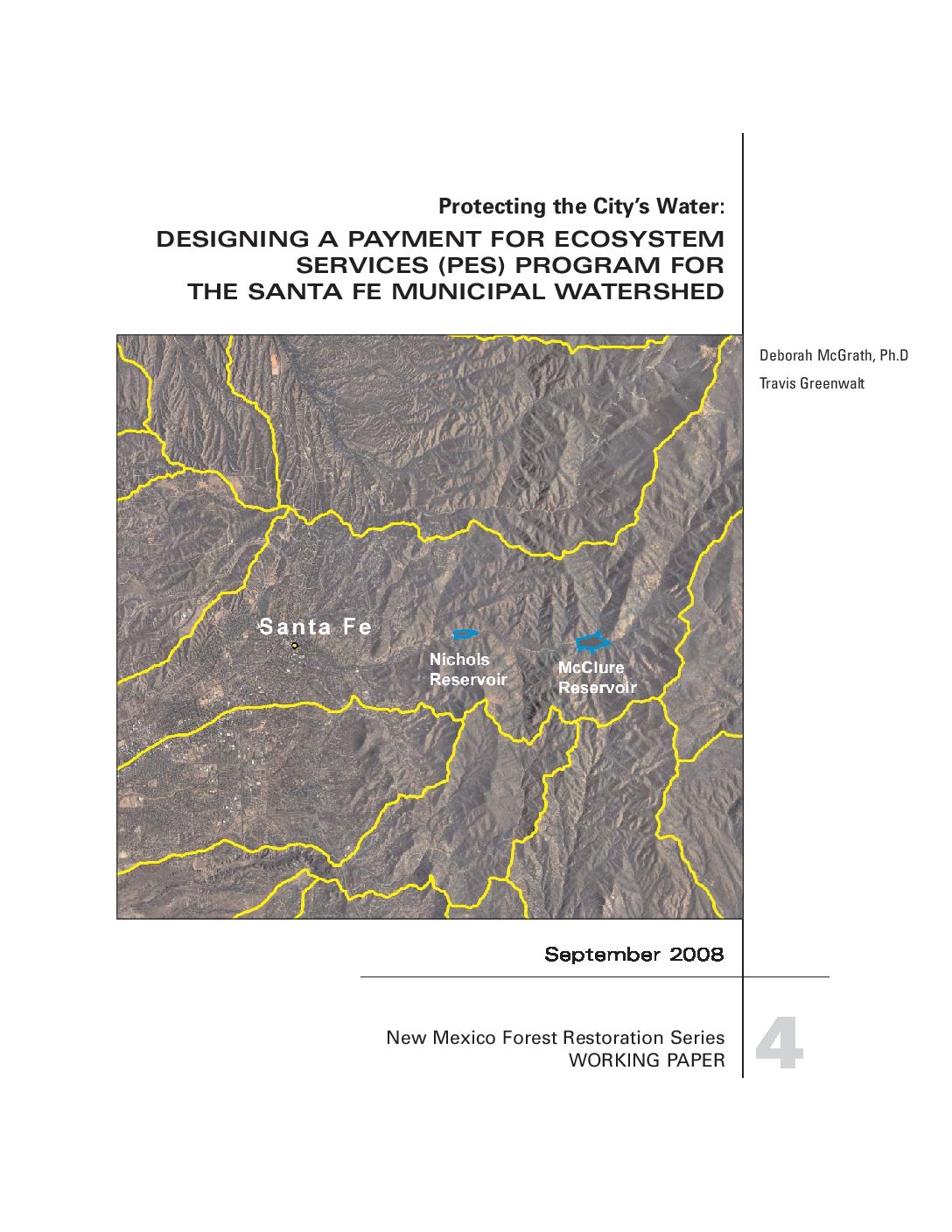
Protecting The City’s Water: Designing A Payment for Ecosystem Services (Pes) Program for The Santa Fe Municipal Watershed
Ecosystem services are the conditions and processes through which natural ecosystems supply benefits to people and communities. Typically, these benefits are not included in conventional markets and are thus unpaid for by recipients. Over the last decade, research has demonstrated that healthy forested watersheds provide numerous economically important services to society. Municipalities, water districts, and other agencies are now aligning economic forces with conservation in ways that explicitly link human and environmental well-being (Daily and Matson 2008). Payment for Ecosystem Services (PES) programs have gained importance worldwide as a new source of income for land acquisition, restoration and conservation activities. These programs provide clear economic incentives for environmental stewardship by landowners and promote greater awareness among consumers of the valuable services provided by ecosystems. As such, PES programs are one method of achieving watershed protection above and beyond what can be accomplished by regulations alone.
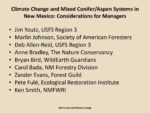
Climate Change and Mixed Conifer/Aspen Systems in New Mexico: Considerations for Managers
Climate Change and Mixed Conifer/Aspen Systems in New Mexico: Considerations for Managers – 2008

Climate Change and Mixed Conifer/Aspen Systems in New Mexico: Considerations for Managers
Although skepticism about the importance of climate change and its anthropogenic influences still exists throughout the various natural resource professions, the tide seems to have turned with respect to forestry. This shift in opinion is exemplified by the U.S. Forest Service’s (USFS) new commitment to the issue. The USFS has recently prioritized climate-based research and Chief Gail Kimbell has stated that “history will judge the leaders of our age by how well we respond to climate change. It is time for a coordinated, agency-wide response to climate change.”
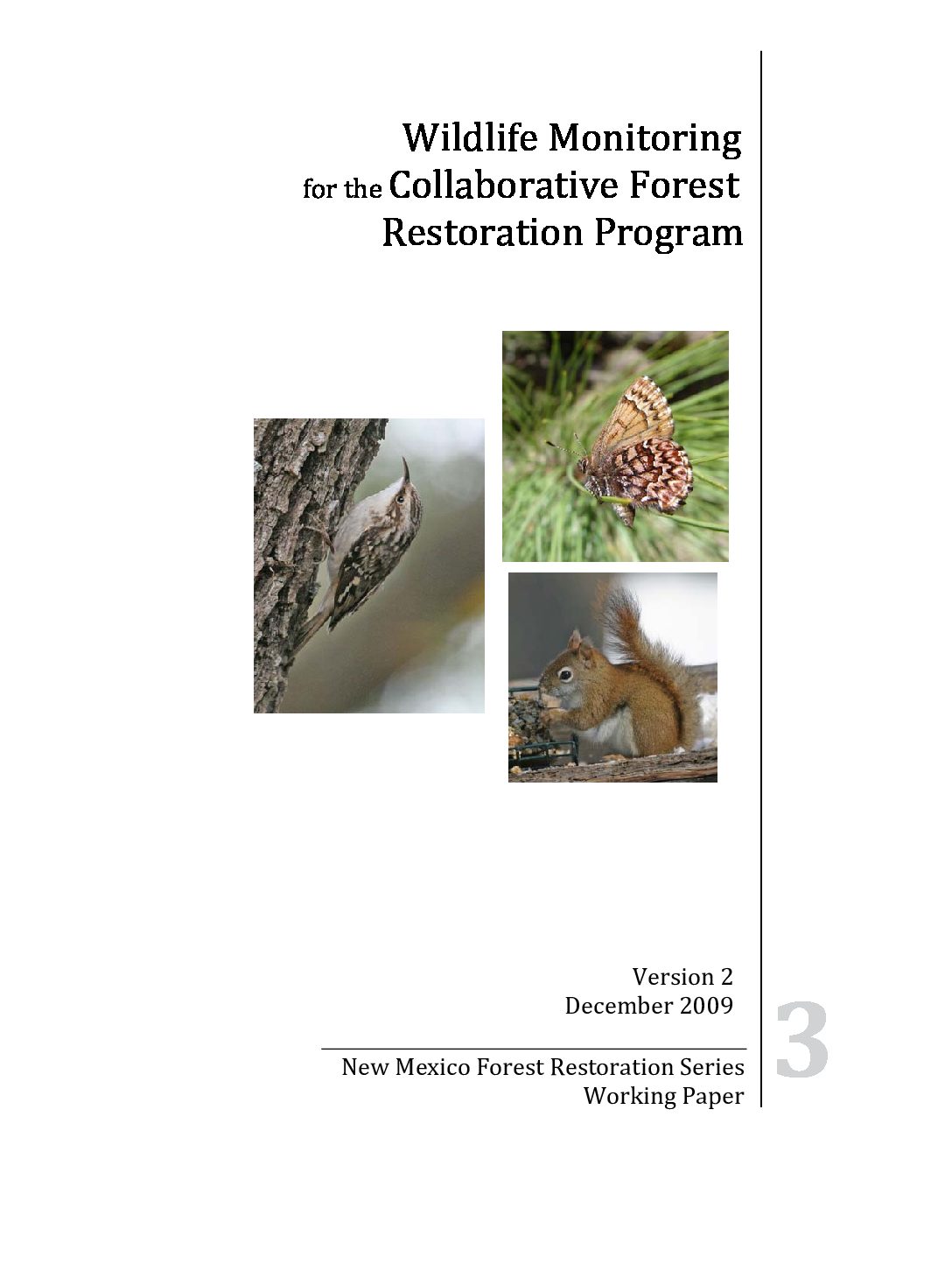
Wildlife Monitoring for the Collaborative Forest Restoration Program
This handbook provides information and protocols for monitoring the following species or species groups: birds, red squirrels, butterflies, mule deer, elk, wild turkey and other wildlife that are detectable by sign (such as Abert’s squirrel, bear and coyote). While other species may also be good indicators of environmental change, these species were chosen because they are relatively easy to monitor, are typically sensitive to change or respond rapidly to change, and are applicable across the state.
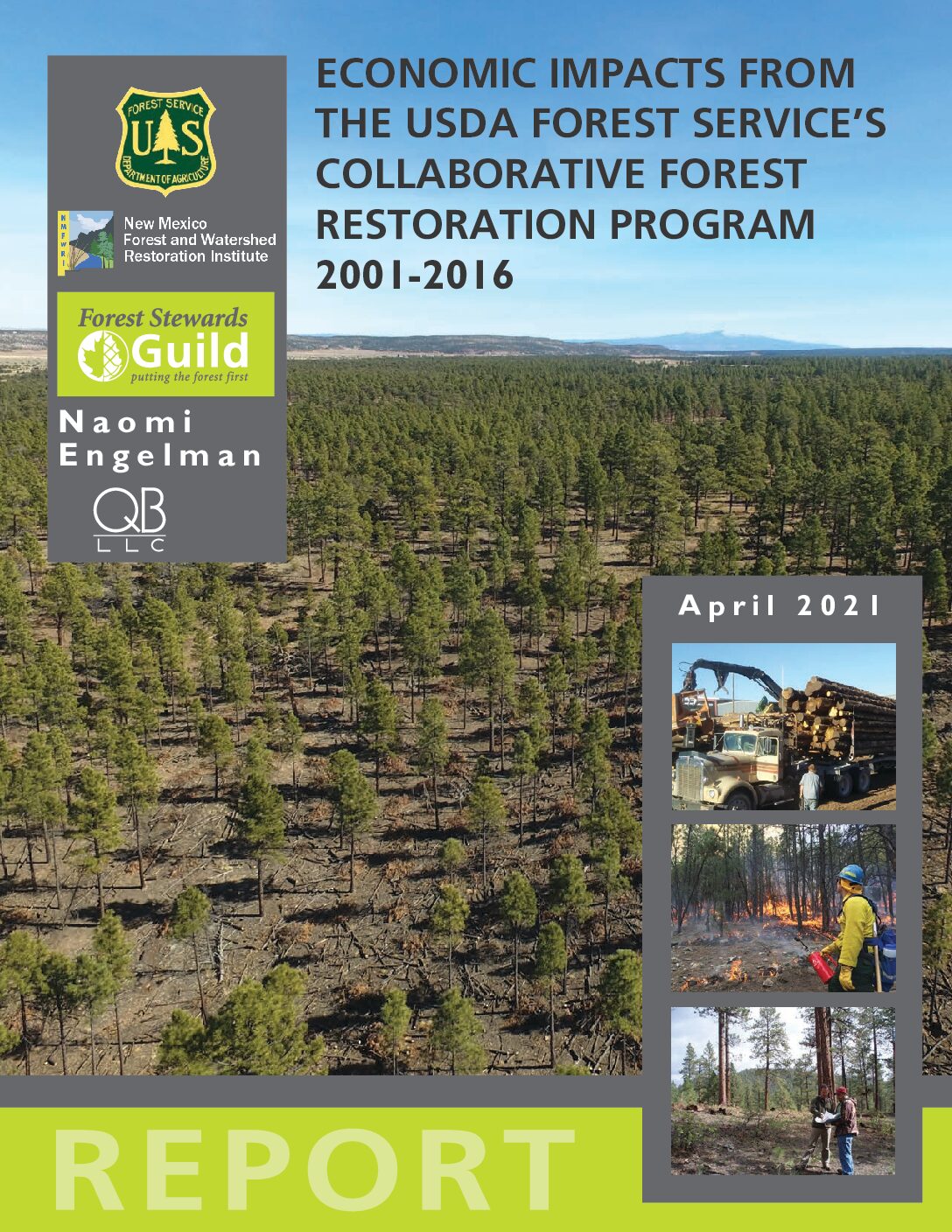
Economic Impacts From the USDA Forest Service’s Collaborative Forest Restoration Program 2001-2016
This report quantifies the CFRP’s contribution to the state’s economy. It provides an in-depth overview of the economic outcomes and impacts from 200 CFRP awards initiated during the 2001- 2016 fiscal year period. The primary purpose of the report is to determine what resulted from the Forest Service’s investment of $60,874,032 in funding that was provided to four types of entities: private companies, non-profit organizations, tribes, and quasi-governmental agencies.
